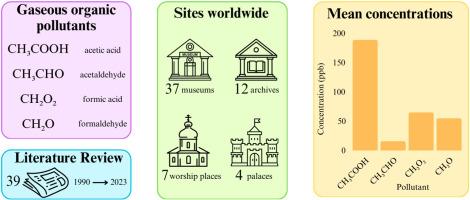Review of organic gaseous pollutant concentrations in indoor conservation spaces
IF 7.3
2区 环境科学与生态学
Q1 ENVIRONMENTAL SCIENCES
引用次数: 0
Abstract
Gaseous organic and inorganic pollutants negatively affect cultural heritage materials, accelerating their deterioration. Although assessing their concentrations is crucial, these pollutants are rarely measured in indoor spaces housing artefacts, known as conservation spaces. This review examines 39 selected studies (1990–2023) encompassing 58 case studies in which gaseous organic pollutants were monitored in such spaces. Acetic and formic acids emerged as primary contributors to the deterioration of collections. The sites monitored, predominantly in Europe, were categorised into three scales: building scale (37 museums, 12 archives, 4 palaces, 7 worship places), room scale (exhibition rooms in 45 sites, storage rooms in 16 sites) and enclosure scale (conservation or display cases, microclimate frames, cabinets in 18 sites). Passive samplers were used more frequently than active ones, with continuous monitoring equipment being limited to total volatile organic compounds (VOCs). Across the sites, the median concentration and 95th percentile values for various pollutants were as follows: acetic acid at 68 ppb and 624 ppb; acetaldehyde at 8 ppb and 77 ppb; formic acid at 30 ppb and 227 ppb; formaldehyde at 27 ppb and 265 ppb; and total VOCs at 66 ppb and 1655 ppb. No clear correlation was found between pollutant concentrations and the use of old versus new enclosures, as both types can contribute to indoor pollution. Further research is needed to develop continuous monitoring technologies, improve active and passive sampling methods and establish standardised concentration thresholds to better preserve cultural heritage.


室内保护空间有机气体污染物浓度研究进展
气态有机和无机污染物对文化遗产材料产生负面影响,加速其变质。尽管评估它们的浓度至关重要,但这些污染物很少在存放文物的室内空间(称为保护空间)中测量。本综述审查了39项选定的研究(1990-2023),其中包括58个案例研究,其中在这些空间中监测了气态有机污染物。乙酸和甲酸是导致收集物变质的主要原因。受监测的遗址主要在欧洲,被分为三种规模:建筑规模(37个博物馆,12个档案馆,4个宫殿,7个礼拜场所),房间规模(45个遗址的展览室,16个遗址的储藏室)和围护规模(18个遗址的保护或陈列柜,微气候框架,橱柜)。被动采样器的使用频率高于主动采样器,连续监测设备仅限于总挥发性有机化合物(VOCs)。在所有站点中,各种污染物的中位数浓度和第95百分位值如下:乙酸为68 ppb和624 ppb;乙醛在8 PPB和77 PPB;甲酸在30 PPB和227 PPB;27 PPB和265 PPB的甲醛;总挥发性有机化合物分别为66 ppb和1655 ppb。污染物浓度与新旧围栏的使用之间没有明显的相关性,因为这两种类型都可能导致室内污染。需要进一步研究开发连续监测技术,改进主动和被动采样方法,建立标准化的浓度阈值,以更好地保护文化遗产。
本文章由计算机程序翻译,如有差异,请以英文原文为准。
求助全文
约1分钟内获得全文
求助全文
来源期刊

Environmental Pollution
环境科学-环境科学
CiteScore
16.00
自引率
6.70%
发文量
2082
审稿时长
2.9 months
期刊介绍:
Environmental Pollution is an international peer-reviewed journal that publishes high-quality research papers and review articles covering all aspects of environmental pollution and its impacts on ecosystems and human health.
Subject areas include, but are not limited to:
• Sources and occurrences of pollutants that are clearly defined and measured in environmental compartments, food and food-related items, and human bodies;
• Interlinks between contaminant exposure and biological, ecological, and human health effects, including those of climate change;
• Contaminants of emerging concerns (including but not limited to antibiotic resistant microorganisms or genes, microplastics/nanoplastics, electronic wastes, light, and noise) and/or their biological, ecological, or human health effects;
• Laboratory and field studies on the remediation/mitigation of environmental pollution via new techniques and with clear links to biological, ecological, or human health effects;
• Modeling of pollution processes, patterns, or trends that is of clear environmental and/or human health interest;
• New techniques that measure and examine environmental occurrences, transport, behavior, and effects of pollutants within the environment or the laboratory, provided that they can be clearly used to address problems within regional or global environmental compartments.
 求助内容:
求助内容: 应助结果提醒方式:
应助结果提醒方式:


